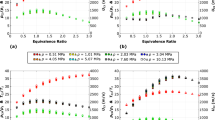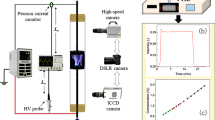Abstract
Upward flame spread is the most rapid and hazardous of the different modes of flame spread. Moreover, studies on the effects of ambient parameters on flame spread are very important for fire safety on spacecraft systems. Therefore, the effects of pressure (0 kPa to 70 kPa), oxygen mole fraction (0.30 to 0.90) and sample width (0.3 cm to 2 cm) on upward flame spread over thin papers were studied. A flame break-off phenomenon over papers was firstly observed, which occurred more likely at high oxygen and high pressure conditions. Upward flame spread reached a steady state by varying the ambient parameters and using narrow samples. The smaller sample width narrowed the flammability limits. Differences in upward and downward flame spread were discussed. We found that a power law relationship between flame spread rate and pressure remained valid near the extinction limit for upward spread, while the power law broke down in the extinction region for downward spread. The controlling mechanism of upward spread was revealed by a pressure modeling method showing that the upward flame spread rate was proportional to the Grashof number raised to an exponent of 0.257. For upward flame spread over narrow solids, the gas phase kinetics and radiation effects are less important compared to the heat convection in the flame spread process, which is quite different from the downward spread. This study contributes to the fire safety of space vehicles and enhances the understanding of the controlling mechanism of flame spread.











Similar content being viewed by others
References
C Chao YH, Fernandez-Pello AC (1995) Concurrent horizontal flame spread: the combined effect of oxidizer flow velocity, turbulence and oxygen concentration. Combust Sci Technol 110–111(1):19–51. https://doi.org/10.1080/00102209508951915
Williams F (1977) Mechanisms of fire spread. In: Symposium (international) on combustion, vol 1. Elsevier, pp 1281–1294
Fernandez-Pello AC, Williams F (1977) A theory of laminar flame spread over flat surfaces of solid combustibles. Combust Flame 28:251–277
Markstein G, De Ris J (1973) Upward fire spread over textiles. In: Symposium (international) on combustion, vol 1. Elsevier, pp 1085–1097
Quintiere J, Harkleroad M, Hasemi Y (1986) Wall flames and implications for upward flame spread. Combust Sci Technol 48(3–4):191–222
Fernandez-Pello AC, Hirano T (1983) Controlling mechanisms of flame spread. Combust Sci Technol 32(1–4):1–31
Gollner MJ, Miller CH, Tang W, Singh AV (2017) The effect of flow and geometry on concurrent flame spread. Fire Saf J 91:68–78. https://doi.org/10.1016/j.firesaf.2017.05.007
Pizzo Y, Consalvi JL, Querre P, Coutin M, Porterie B (2009) Width effects on the early stage of upward flame spread over PMMA slabs: experimental observations. Fire Saf J 44(3):407–414. https://doi.org/10.1016/j.firesaf.2008.09.003
Jiang L, He JJ, Sun JH (2018) Sample width and thickness effects on upward flame spread over PMMA surface. J Hazard Mater 342:114–120. https://doi.org/10.1016/j.jhazmat.2017.08.022
Tsai K-C (2009) Width effect on upward flame spread. Fire Saf J 44(7):962–967. https://doi.org/10.1016/j.firesaf.2009.06.003
Tsai K-C (2011) Influence of sidewalls on width effects of upward flame spread. Fire Saf J 46(5):294–304
Rangwala AS, Buckley SG, Torero JL (2007) Upward flame spread on a vertically oriented fuel surface: The effect of finite width. Proc Combust Inst 31:2607–2615. https://doi.org/10.1016/j.proci.2006.07.235
Honda LK, Ronney PD (2000) Mechanisms of concurrent-flow flame spread over solid fuel beds. Proc Combust Inst 28:2793–2801
Urban DL, Ferkul P, Olson S, Ruff GA, Easton J, T’ien JS, Liao Y-TT, Li C, Fernandez-Pello C, Torero JL, Legros G, Eigenbrod C, Smirnov N, Fujita O, Rouvreau S, Toth B, Jomaas G (2019) Flame spread: effects of microgravity and scale. Combust Flame 199:168–182. https://doi.org/10.1016/j.combustflame.2018.10.012
Jiang C-B, Tien JS, Shih H-Y (1996) Model calculation of steady upward flame spread over a thin solid in reduced gravity. In: Symposium (international) on combustion, vol 1. Elsevier, pp 1353–1360
Shih H-Y (2009) Computed flammability limits and spreading rates of upward flame spread over a thin solid in low-speed buoyant flows. Combust Sci Technol 181(2):379–395
Kleinhenz J, Feier II, Hsu S-Y, T’ien JS, Ferkul PV, Sacksteder KR (2008) Pressure modeling of upward flame spread and burning rates over solids in partial gravity. Combust Flame 154(4):637–643. https://doi.org/10.1016/j.combustflame.2008.05.023
Chu L, Chen CH, T’ien JS (1981) ASME paper No 81-WA/HT-42
Zhao X, Liao Y-TT, Johnston MC, T’Ien JS, Ferkul PV, Olson SL (2017) Concurrent flame growth, spread, and quenching over composite fabric samples in low speed purely forced flow in microgravity. Proc Combust Inst 36 (2):2971–2978. https://doi.org/10.1016/j.proci.2016.06.028
Thomsen M, Fernandez-Pello C, Ruff GA, Urban DL (2019) Buoyancy effects on concurrent flame spread over thick PMMA. Combust Flame 199:279–291. https://doi.org/10.1016/j.combustflame.2018.10.016
Thomsen M, Fernandez-Pello C, Urban DL, Ruff GA, Olson SL (2019) On simulating concurrent flame spread in reduced gravity by reducing ambient pressure. Proc Combust Inst 37(3):3793–3800. https://doi.org/10.1016/j.proci.2018.05.004
Kleinhenz J, Yuan Z-G (2011) An experimental study of upward burning over long solid fuels: facility development and comparison. NASA Glenn Research Center, Cleveland
Kleinhenz JE, T’Ien JS (2007) Combustion of Nomex® III fabric in potential space habitat atmospheres: cyclic flame spread phenomenon. Combust Sci Technol 179(10):2153–2169. https://doi.org/10.1080/00102200701386172
Li C, Liao Y-TT (2018) Numerical investigation of flame splitting phenomenon in upward flame spread over solids with a two-stage pyrolysis model. Combust Sci Technol 190(12):2082–2096. https://doi.org/10.1080/00102202.2018.1489380
McAllister S, Fernandez-Pello C, Urban D, Ruff G (2010) The combined effect of pressure and oxygen concentration on piloted ignition of a solid combustible. Combust Flame 157(9):1753–1759. https://doi.org/10.1016/j.combustflame.2010.02.022
McAlevy RF, Magee RS (1969) The mechanism of flame spreading over the surface of igniting condensed-phase materials. In: Symposium (international) on combustion, vol 1. Elsevier, pp 215–227
Frey AE, T’ien JS (1976) Near-limit flame spread over paper samples. Combust Flame 26:257–267
De Ris J, Kanury AM, Yuen M (1973) Pressure modeling of fires. In: Symposium (international) on combustion, vol 1. Elsevier, pp 1033–1044
Alpert R (1977) Pressure modeling of transient crib fires. Combust Sci Technol 15(1–2):11–20
Altenkirch R, Eichhorn R, Shang P (1980) Buoyancy effects on flames spreading down thermally thin fuels. Combust Flame 37:71–83
Quintiere JG (2006) Fundamentals of fire phenomena. Wiley, Chichester
Gebhart B, Jaluria Y, Mahajan RL, Sammakia B (1988) Buoyancy-induced flows and transport. Springer, Berlin
Bergman TL, Lavin AS, Incropera FP, Dewitt DP (2011) Fundamentals of heat and mass transfer, 7th edn. Wiley, Hoboken
Delichatsios M (1986) Exact solution for the rate of creeping flame spread over thermally thin materials. Combust Sci Technol 44(5–6):257–267
Acknowledgements
This work was sponsored by the NSFC (51576186, 51636008, 51323010), Key Research Program of the CAS (QYZDB-SSW-JSC029), National Key R&D Program (2016YFC0801504) and Fundamental Research Funds for the Central Universities (WK2320000034, WK2320000036, WK2320000042). We would like to thank Dr. James S. T’ien for providing us with their research paper.
Author information
Authors and Affiliations
Corresponding author
Additional information
Publisher's Note
Springer Nature remains neutral with regard to jurisdictional claims in published maps and institutional affiliations.
Rights and permissions
About this article
Cite this article
Zhao, L., Fang, J., Tao, S. et al. Effects of Ambient Parameters and Sample Width on Upward Flame Spread over Thermally Thin Solids. Fire Technol 57, 145–161 (2021). https://doi.org/10.1007/s10694-020-00987-x
Received:
Accepted:
Published:
Issue Date:
DOI: https://doi.org/10.1007/s10694-020-00987-x




